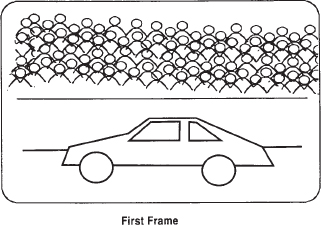Compression takes place between frames as well.
Temporal Compression
Although spatial compression removes redundancies from individual frames, there is also a great deal of redundancy from frame to frame. Temporal compression deals with this problem. While a number of approaches and very complicated algorithms are used, let's look at the general concept.
In order to understand how temporal compression works, it might be easier to deal with just two individual frames of video, one right after the other. In the first frame, a race car is speeding around the race track. If we look at the next frame of video, which happens only one one-thirtieth of a second later, the two frames are almost identical. Things have moved a little, but in such a short period of time not very much can change. Using video compression, the system would send the first frame down the line where it would be both displayed and held in a memory. But instead of sending all of the information of the second frame, the system would send only the information that was different from that in the first frame. On the receiving end, a computer program would take the information from the first frame that has not changed and combine it with the new information from the second frame. This new second frame would then be displayed and stored in the memory, where the process would start over again with just the new information for the third frame coming down the line. You can see that this process would greatly reduce the amount of information being transmitted at any one time, but it would require much more sophisticated equipment at both the transmitting and receiving ends.
Compression is often described by its compression ratio. It might be spoken of as 2:1 (two to one) compression or 4:1 (four to one) compression. What this means is that if you take the bandwidth it takes to carry one complete uncompressed video signal, with 4:1 compression you could fit four complete video signals in that same bandwidth. The higher the compression ratio, the greater the expectation of poor quality in the final picture.
Video compression can be used almost anywhere video information has to be stored (whether on tape or on some sort of computer memory device), or for transmitting information through cable or over the air. But compression is always a compromise. Many professionals hate the “C” word (compression) because it means compromise and loss of information. Compression is a fact of life, however, and many nonlinear editors and digital video recording formats would be unable to function without it.

Video compression.

